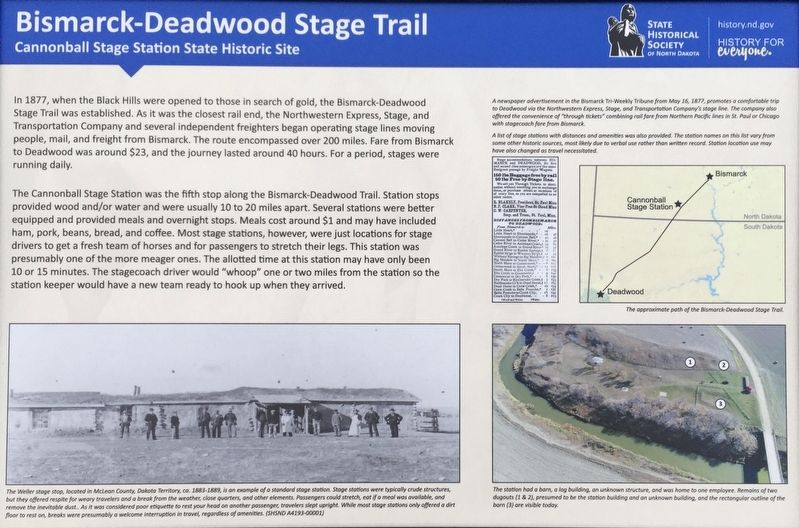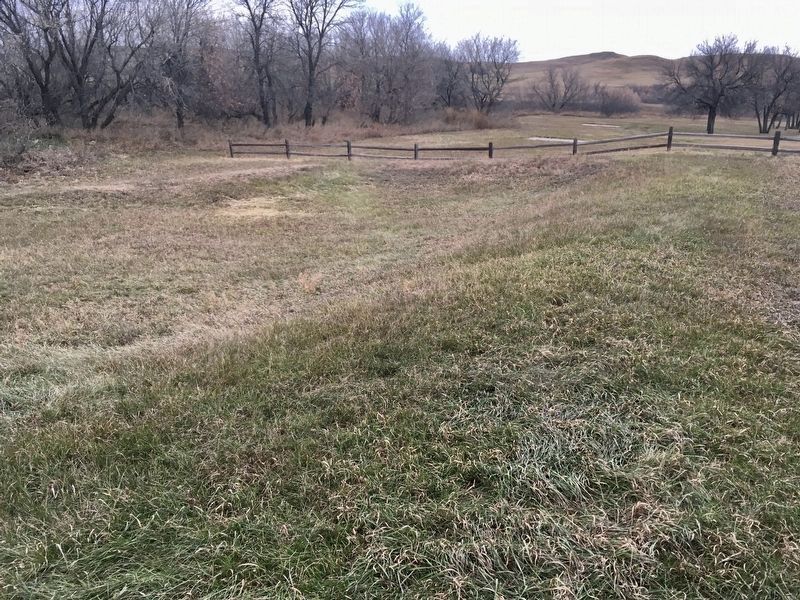Bismarck-Deadwood Stage Trail
— Cannonball Stage Station State Historic Site —
The Cannonball Stage Station was the fifth stop along the Bismarck-Deadwood Trail. Station stops provided wood and/or water and were usually 10 to 20 miles apart. Several stations were better equipped and provided meals and overnight stops. Meal cost around $1 and may have included hame, pork, beans, bread, and coffee. Most stage stations, however, were just locations for stage drivers to get a fresh team of horses and for passengers to stretch their legs. This station was presumably one of the more meager ones. The allotted time at this station may have been only 10 or 15 minutes. The stagecoach driver would "whoop" one or two miles from the station so the station keeper would have a new team ready to hook up when they arrived.
Photo captions:
Top left: A newspaper advertisement in the Bismarck Tri-Weekly Tribune
from May 16, 1877, promotes a comfortable trip to Deadwood via the Northwestern Express, Stage, and Transportation Company's stage line. The company also offered the convenience of "through tickets" combining rail fare from Northern Pacific lines in St. Paul or Chicago with stagecoach fare from Bismarck.
A list of stage stations with distances and amenities were also provided. The station names on this list vary from some other historic sources, most likely due to verbal use rather than written record. Station location use may have also changed as travel necessitated.
Bottom left: The Weller stage stop, located in McLean County, Dakota Territory, ca 1883-1889, is an example of a standard stage station. Stage stations were typically crude structures, but they offered respite for weary travelers and a break from the weather, close quarters, and other elements. Passengers could stretch, eat if a meal was available, and remove the inevitable dust. As it was considered poor etiquette to rest your head on another passenger, travelers slept upright. While most stage stations only offered a dirt floor to rest on, breaks were presumably a welcome interruption in travel, regardless of amenities.
Bottom right: The station had a barn, a log building, an unknown structure, and was home to one employee. Remains of two dugouts (1&2), presumed to be the station building and an unknown building and the rectangular outline of the barn (3) are visible today.
Erected by State Historical Society of North Dakota.
Topics. This historical marker is listed in this topic list: Roads & Vehicles. A significant historical year for this entry is 1877.
Location. 46° 13.304′ N, 101° 28.645′ W. Marker is in Carson, North Dakota, in Grant County. Marker can be reached from 53rd Avenue SW, on the right when traveling south. Touch for map. Marker is at or near this postal address: 8293 53rd Ave SW, Carson ND 58529, United States of America. Touch for directions.
Other nearby markers. At least 2 other markers are within walking distance of this marker. Cannonball Stage Station (here, next to this marker); Passenger Coaches (a few steps from this marker).
Also see . . . Cannonball Stage Station State Historic Site. (Submitted on August 2, 2020, by Connor Olson of Kewaskum, Wisconsin.)
Credits. This page was last revised on August 3, 2020. It was originally submitted on July 19, 2020, by Connor Olson of Kewaskum, Wisconsin. This page has been viewed 535 times since then and 112 times this year. Photos: 1, 2, 3. submitted on July 19, 2020, by Connor Olson of Kewaskum, Wisconsin. • Mark Hilton was the editor who published this page.
Editor’s want-list for this marker. A wide shot of the marker and its surroundings. • Can you help?


